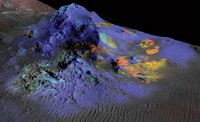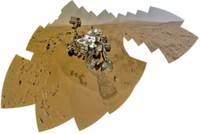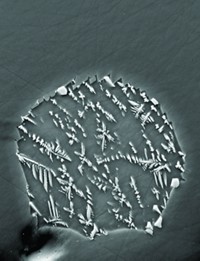Advertisement
Grab your lab coat. Let's get started
Welcome!
Welcome!
Create an account below to get 6 C&EN articles per month, receive newsletters and more - all free.
It seems this is your first time logging in online. Please enter the following information to continue.
As an ACS member you automatically get access to this site. All we need is few more details to create your reading experience.
Not you? Sign in with a different account.
Not you? Sign in with a different account.
ERROR 1
ERROR 1
ERROR 2
ERROR 2
ERROR 2
ERROR 2
ERROR 2
Password and Confirm password must match.
If you have an ACS member number, please enter it here so we can link this account to your membership. (optional)
ERROR 2
ACS values your privacy. By submitting your information, you are gaining access to C&EN and subscribing to our weekly newsletter. We use the information you provide to make your reading experience better, and we will never sell your data to third party members.
Policy
Rock Star
A science writer tells the story—or at least some of it—behind a controversial meteorite from Mars
by Alan Treiman
March 19, 2007
| A version of this story appeared in
Volume 85, Issue 12

"The Rock from Mars: A True Detective Story on Two Planets" chronicles the martian meteorite ALH84001 and the claim that it contains traces of ancient martian life. Author Kathy Sawyer, a veteran science writer, emphasizes the people behind the story—those who found the meteorite, those who recognized its martian origin, and the research group of David S. McKay at NASA's Johnson Space Center (JSC) in Houston that proposed that the meteorite contains evidence of martian life.
"The Rock from Mars" is engaging, smoothly written, and gives a sympathetic human face to the scientists involved, especially those in McKay's group. A quarter of the book is taken up by notes, which let the text flow freely but provide firm documentation for the story told. "The Rock from Mars" is an easy read, with accurate science, on a major scientific controversy of our time.
The book, however, does not tell the whole story of ALH84001 in terms of time, science, or people. Events after 1996—the date of a NASA press conference announcing the possible martian life findings—are covered selectively, many scientific issues are barely mentioned, and important people in this saga are omitted. And at the end, "The Rock from Mars" avoids the real questions: Where is the ALH84001 controversy now, and was there ever life on Mars?
I should point out that I have been involved with the ALH84001 meteorite from nearly the beginning of its story, having studied Mars and its meteorites since 1984. I worked for a time at JSC and now work nearby as a researcher at the Lunar & Planetary Institute, which is funded by NASA. I have written several technical papers about ALH84001, mostly establishing how the "evidence for ancient martian life" could have formed without life. I was interviewed for Sawyer's book and appear nearly incognito in one photograph. I have received no compensation whatever from the book.
The first three of 15 chapters in "The Rock from Mars" lay the foundation for the story of ALH84001, with accurate science briefs and engaging personality portraits. They include the find of ALH84001 in Antarctica by Roberta Score, then with Lockheed Martin at JSC; recognition of its martian origin by David (Duck) Mittlefehldt, also with Lockheed Martin at JSC; McKay's long experience in geology and lunar soils that prepared him for investigating ALH84001; and the first wild notion from Christopher Romanek, then a postdoctoral researcher at JSC, that the meteorite might contain martian fossils. These chapters are great but would have benefited from a few more pages explaining why some meteorites are thought to be from Mars (they contain gas of the same composition as the martian atmosphere, which the Viking landers analyzed on Mars), how the meteorites left Mars (ejected by asteroid impacts), and how they wandered to Earth (orbital perturbations by Mars and by asteroids).
The next four chapters follow McKay's research group on the way to their 1996 Science paper, in which the group proposes that ALH84001 contains evidence of ancient martian microbes (Science 1996, 273, 924). From her in-depth interviews, Sawyer tells a fascinating tale of how chance favors the prepared mind, as well as how one's background colors one's perceptions.
Romanek was first with the idea that ALH84001 might preserve traces of martian life, after learning from Mittlefehldt of the meteorite and its little disks of carbonate minerals. Romanek knew about carbonate rocks on Earth, and he knew that they commonly preserve fossils. His first scanning electron microscopy (SEM) images of the carbonate disks, acid-etched to enhance their structures, showed abundant bacteria. He recognized these quickly as contaminants from sample preparation. Cleaner sample preparations removed the Earth bacteria but not the idea of life in the martian meteorite. Romanek next brought his work to Everett Gibson, who was working with McKay at JSC, and to McKay himself, and the game was afoot.
But in her interviews, Sawyer skipped two crucial questions. First, why did McKay's group choose secrecy? From Romanek's first SEM images of bacteria in ALH84001, he, McKay, and Gibson agreed to work in secret. This is peculiar, as the whole research began in scientific collegiality, with an intellectual gift from Mittlefehldt to Romanek. Sawyer doesn't ask what McKay's group expected to gain from secrecy, or what they may have feared from continued collegiality.
Second, why did McKay's group choose to publish when they did? Their 1996 Science paper gave five "maybe" lines of evidence for ancient martian life in ALH84001, and it argued that the maybes, put together, became a compelling case. Almost no researcher in biology, astrobiology, or meteorites has accepted their logic, so it is hard to understand why McKay's group did not strive for more convincing data.
Chapters eight through 12 follow McKay's group from submission of their paper to Science to the heady NASA press conference of Aug. 7, 1996. Here, Sawyer is at her best, weaving science and Washington, D.C., politics into a tale of political agendas, scientific embargo, overweening egos, and "lab rats" in a strange land.

The final, unsatisfying chapters follow McKay's group and some of the ensuing debate to the present. Sawyer selects only a few lines of a complex scientific debate, emphasizing the results most flattering to McKay's group. This is not hard-hitting or even-handed journalism, but warm praise.
One chapter discusses the tiny oddly shaped magnetite grains (only about 100 nm long) in the carbonate disks. Kathie Thomas-Keprta of McKay's group studied them through the transmission electron microscope and found them to be identical to magnetite grains made by some Earth bacteria. She inferred that the oddly shaped magnetite grains were from martian microbes, and the chapter emphasizes her follow-up investigations to prove the point.
But contrary work is barely mentioned. D. C. Golden of Lockheed Martin at JSC has shown that the magnetite grains, in their odd shapes, would have formed in the impact shocks that ALH84001 suffered while still on Mars, long before it traveled to Earth. Golden has also shown, in painstaking detail, that the ALH84001 magnetites do not have the same shapes as the magnetite grains made by Earth bacteria (Am. Mineral. 2004, 89, 681). Thomas-Keprta and McKay got it wrong.
Another chapter targets William Schopf, a professor of paleobiology at the University of California, Los Angeles. He is an expert on the most ancient fossil microbes on Earth, has been a vocal critic of McKay's group, and was the external critical expert in the 1996 NASA press conference. There and since, he has argued forcefully that McKay's evidence of ancient martian life was inadequate and proved nothing.
Sawyer points out that Schopf now stands accused of failing to report evidence that some of his ancient microbial "fossils" are not biological. Most of this chapter follows a 2002 debate between Schopf and his outspoken critic, Martin Brasier, a professor of paleobiology at Oxford University (Nature 2002, 416, 76).
None of this is really relevant to ALH84001, except by impugning the character of Schopf. His criticisms of McKay's work should be judged on their merits, and McKay should not take comfort in an adversary's distress.
The final chapter is an upbeat account of the good that has come from the McKay group's work on ALH84001. This is true, but a pulled punch, because Sawyer omits nearly all the scientific work on ALH84001 since 1996, the slow grind of testing McKay's contentions and evaluating the evidence for and against martian biology. The consensus today is not upbeat. Reasonable inorganic processes have been found for everything-the carbonate disks could have been deposited from sterile solutions, the organic matter could have formed by Fischer-Tropsch-like processes, the bacterial shapes may be terrestrial contaminants or artifacts of sample preparation, and the tiny oddly shaped magnetites could have formed by thermal breakdown of iron-rich carbonate minerals. But this story, and the research and personalities behind it, must wait for another book.
Allan Treiman is a senior staff scientist at the Lunar & Planetary Institute, which is funded by NASA to do research and education in planetary sciences. Since 1997, he has argued that McKay's traces of martian life in the meteorite ALH84001 formed without any interaction with life and so he clashes occasionally with McKay, his group, and their followers.





Join the conversation
Contact the reporter
Submit a Letter to the Editor for publication
Engage with us on Twitter